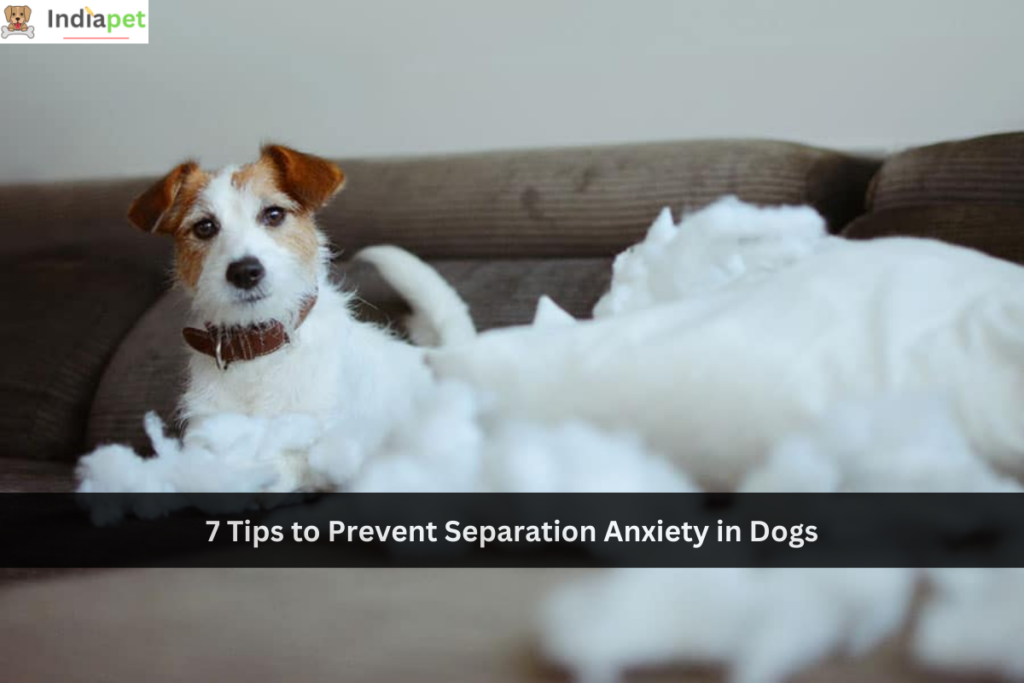7 Tips to Prevent Separation Anxiety in Dogs: Are you a pet parent who gets concerned every time you leave your furry friend alone at home? Separation anxiety in dogs can be a distressing experience, both for them and their owners.
7 Tips to Prevent Separation Anxiety in Dogs
But don’t worry; we’re here to help! In this article, we’ll share seven expert tips to prevent separation anxiety in your beloved canine companion. Whether you’re a new dog owner or have been facing this issue for a while, these strategies will provide you with practical solutions to ease your dog’s anxiety.
Understanding Separation Anxiety in Dogs
Separation anxiety is a common behavioral issue among dogs and occurs when they become distressed or anxious when left alone. This condition can manifest in various ways, such as excessive barking, destructive behavior, urinating or defecating indoors, or even attempting to escape.
It’s important to understand that separation anxiety is not a reflection of your dog’s misbehavior or disobedience, but rather a sign of their distress and emotional insecurity. To effectively address separation anxiety, it is crucial to recognize the signs and symptoms.
Signs and Symptoms of Separation Anxiety
Separation anxiety can present itself through a range of behavioral signs that indicate your dog is experiencing distress when left alone. These signs may include:
- Excessive barking or howling
- Destructive behavior, such as chewing furniture or scratching doors
- Pacing or restlessness
- Urinating or defecating indoors, even when house-trained
- Attempts to escape, such as scratching at doors or windows
- Loss of appetite or excessive panting
- Excessive salivation or drooling
If you notice these signs consistently when you leave your dog alone, it’s likely they are suffering from separation anxiety. Now that we have a better understanding of the condition, let’s explore some effective strategies to prevent separation anxiety in dogs.
Tips to Prevent Separation Anxiety in Dogs – Establish a Routine
Dogs thrive on routine and predictability. Establishing a consistent daily routine can help alleviate their anxiety by providing them with a sense of stability and structure. Create a schedule for feeding times, exercise, playtime, and rest. Stick to this routine as much as possible, even on weekends or days off work.
When it comes to departures and arrivals, keep them low-key. Avoid making a big fuss or giving excessive attention before leaving or when returning home. By treating departures and arrivals as normal parts of the daily routine, you can help your dog understand that being alone is a regular occurrence and nothing to be anxious about.
Tips to Prevent Separation Anxiety in Dogs – Providing Mental Stimulation
Mental stimulation is essential for preventing separation anxiety in dogs. Boredom can exacerbate anxiety and destructive behavior. Provide your dog with plenty of mental stimulation through interactive toys, puzzle feeders, and training exercises.
Engage their mind and challenge their problem-solving skills to keep them occupied and mentally fulfilled. Consider incorporating activities such as hide-and-seek, obedience training, or scent games into their daily routine. These activities not only provide mental stimulation but also strengthen the bond between you and your dog.
Tips to Prevent Separation Anxiety in Dogs – Using Positive Reinforcement
Positive reinforcement is a powerful tool in shaping your dog’s behavior and building their confidence. Reward your dog for calm and relaxed behavior when alone. Start by leaving them alone for a short period and rewarding them with treats or praise when they remain calm. Gradually increase the duration and reinforce the positive behavior consistently.
Avoid punishing or scolding your dog for displaying signs of anxiety. This will only increase their stress levels and worsen their separation anxiety. Instead, focus on rewarding and reinforcing desirable behaviors, such as being calm, relaxed, and independent. This will help them associate being alone with positive experiences and reduce anxiety over time.
Also See:
How To Teach Your Dog Not to Jump Up
Common Mistakes to Avoid When Dealing with Separation Anxiety
When dealing with separation anxiety in dogs, it’s important to avoid common mistakes that can inadvertently reinforce their anxiety. Some common mistakes to avoid include:
- Punishing your dog for their anxious behavior
- Reinforcing attention-seeking behavior by providing excessive attention before leaving or upon returning home
- Using negative reinforcement or aversive training methods
- Ignoring the problem and hoping it will resolve on its own
By steering clear of these mistakes and implementing the strategies we’ve discussed, you can effectively prevent separation anxiety in your beloved canine companion.
Conclusion
Separation anxiety in dogs can be a challenging issue to address, but with the right strategies and consistent training, it is possible to prevent and manage this condition. By understanding the signs and symptoms, providing proper training and socialization, establishing a routine, practicing gradual departures and arrivals, providing mental stimulation, using positive reinforcement, and seeking professional help when needed, you can help your dog feel more secure and less anxious when left alone.
Remember, patience and consistency are key when addressing separation anxiety. With time, effort, and a deep understanding of your dog’s needs, you can strengthen the bond you share with your furry friend and create a loving and anxiety-free environment for them.
If you like this Article about 7 Tips to Prevent Separation Anxiety in Dogs please share this Article with your friends and family members.


